Alessandro Sordoni
debug-gym: A Text-Based Environment for Interactive Debugging
Mar 27, 2025Abstract:Large Language Models (LLMs) are increasingly relied upon for coding tasks, yet in most scenarios it is assumed that all relevant information can be either accessed in context or matches their training data. We posit that LLMs can benefit from the ability to interactively explore a codebase to gather the information relevant to their task. To achieve this, we present a textual environment, namely debug-gym, for developing LLM-based agents in an interactive coding setting. Our environment is lightweight and provides a preset of useful tools, such as a Python debugger (pdb), designed to facilitate an LLM-based agent's interactive debugging. Beyond coding and debugging tasks, this approach can be generalized to other tasks that would benefit from information-seeking behavior by an LLM agent.
Training Plug-n-Play Knowledge Modules with Deep Context Distillation
Mar 11, 2025Abstract:Dynamically integrating new or rapidly evolving information after (Large) Language Model pre-training remains challenging, particularly in low-data scenarios or when dealing with private and specialized documents. In-context learning and retrieval-augmented generation (RAG) face limitations, including their high inference costs and their inability to capture global document information. In this paper, we propose a way of modularizing knowledge by training document-level Knowledge Modules (KMs). KMs are lightweight components implemented as parameter-efficient LoRA modules, which are trained to store information about new documents and can be easily plugged into models on demand. We show that next-token prediction performs poorly as the training objective for KMs. We instead propose Deep Context Distillation: we learn KMs parameters such as to simulate hidden states and logits of a teacher that takes the document in context. Our method outperforms standard next-token prediction and pre-instruction training techniques, across two datasets. Finally, we highlight synergies between KMs and retrieval-augmented generation.
VinePPO: Unlocking RL Potential For LLM Reasoning Through Refined Credit Assignment
Oct 02, 2024



Abstract:Large language models (LLMs) are increasingly applied to complex reasoning tasks that require executing several complex steps before receiving any reward. Properly assigning credit to these steps is essential for enhancing model performance. Proximal Policy Optimization (PPO), a state-of-the-art reinforcement learning (RL) algorithm used for LLM finetuning, employs value networks to tackle credit assignment. However, value networks face challenges in predicting the expected cumulative rewards accurately in complex reasoning tasks, often leading to high-variance updates and suboptimal performance. In this work, we systematically evaluate the efficacy of value networks and reveal their significant shortcomings in reasoning-heavy LLM tasks, showing that they barely outperform a random baseline when comparing alternative steps. To address this, we propose VinePPO, a straightforward approach that leverages the flexibility of language environments to compute unbiased Monte Carlo-based estimates, bypassing the need for large value networks. Our method consistently outperforms PPO and other RL-free baselines across MATH and GSM8K datasets with fewer gradient updates (up to 9x), less wall-clock time (up to 3.0x). These results emphasize the importance of accurate credit assignment in RL finetuning of LLM and demonstrate VinePPO's potential as a superior alternative.
Not All LLM Reasoners Are Created Equal
Oct 02, 2024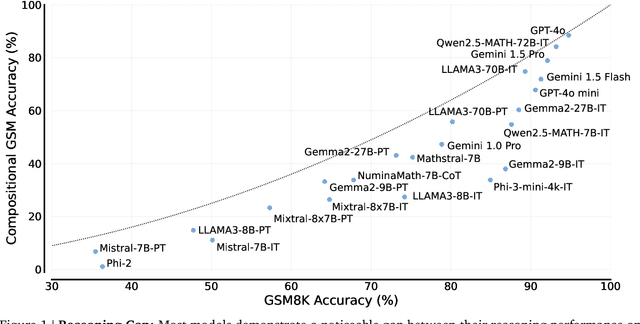
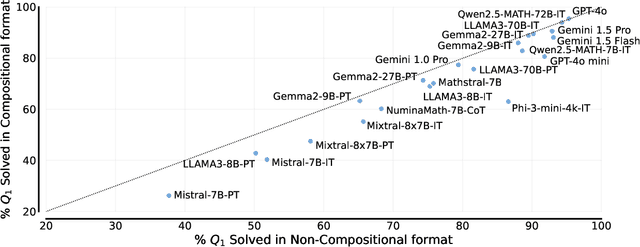
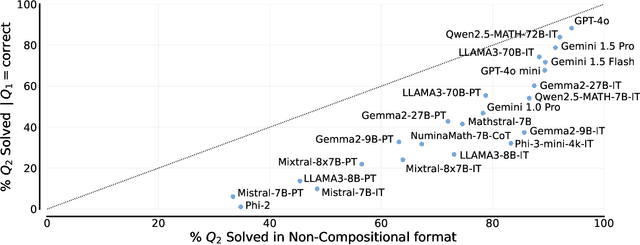
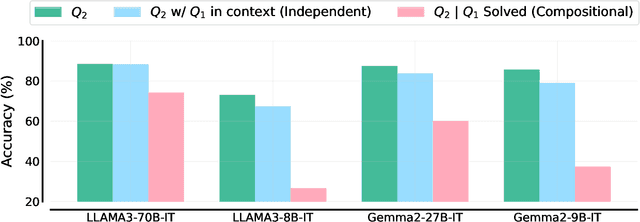
Abstract:We study the depth of grade-school math (GSM) problem-solving capabilities of LLMs. To this end, we evaluate their performance on pairs of existing math word problems together so that the answer to the second problem depends on correctly answering the first problem. Our findings reveal a significant reasoning gap in most LLMs, that is performance difference between solving the compositional pairs and solving each question independently. This gap is more pronounced in smaller, more cost-efficient, and math-specialized models. Moreover, instruction-tuning recipes and code generation have varying effects across LLM sizes, while finetuning on GSM can lead to task overfitting. Our analysis indicates that large reasoning gaps are not because of test-set leakage, but due to distraction from additional context and poor second-hop reasoning. Overall, LLMs exhibit systematic differences in their reasoning abilities, despite what their performance on standard benchmarks indicates.
A Survey on Model MoErging: Recycling and Routing Among Specialized Experts for Collaborative Learning
Aug 13, 2024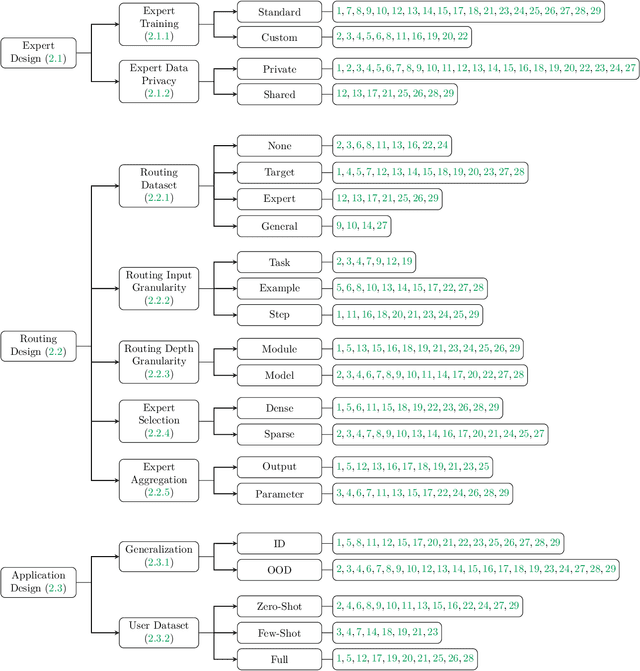
Abstract:The availability of performant pre-trained models has led to a proliferation of fine-tuned expert models that are specialized to a particular domain or task. Model MoErging methods aim to recycle expert models to create an aggregate system with improved performance or generalization. A key component of MoErging methods is the creation of a router that decides which expert model(s) to use for a particular input or application. The promise, effectiveness, and large design space of MoErging has spurred the development of many new methods over the past few years. This rapid pace of development has made it challenging to compare different MoErging methods, which are rarely compared to one another and are often validated in different experimental setups. To remedy such gaps, we present a comprehensive survey of MoErging methods that includes a novel taxonomy for cataloging key design choices and clarifying suitable applications for each method. Apart from surveying MoErging research, we inventory software tools and applications that make use of MoErging. We additionally discuss related fields of study such as model merging, multitask learning, and mixture-of-experts models. Taken as a whole, our survey provides a unified overview of existing MoErging methods and creates a solid foundation for future work in this burgeoning field.
Improving Context-Aware Preference Modeling for Language Models
Jul 20, 2024



Abstract:While finetuning language models from pairwise preferences has proven remarkably effective, the underspecified nature of natural language presents critical challenges. Direct preference feedback is uninterpretable, difficult to provide where multidimensional criteria may apply, and often inconsistent, either because it is based on incomplete instructions or provided by diverse principals. To address these challenges, we consider the two-step preference modeling procedure that first resolves the under-specification by selecting a context, and then evaluates preference with respect to the chosen context. We decompose reward modeling error according to these two steps, which suggests that supervising context in addition to context-specific preference may be a viable approach to aligning models with diverse human preferences. For this to work, the ability of models to evaluate context-specific preference is critical. To this end, we contribute context-conditioned preference datasets and accompanying experiments that investigate the ability of language models to evaluate context-specific preference. We use our datasets to (1) show that existing preference models benefit from, but fail to fully consider, added context, (2) finetune a context-aware reward model with context-specific performance exceeding that of GPT-4 and Llama 3 70B on tested datasets, and (3) investigate the value of context-aware preference modeling.
Efficient Adversarial Training in LLMs with Continuous Attacks
May 24, 2024



Abstract:Large language models (LLMs) are vulnerable to adversarial attacks that can bypass their safety guardrails. In many domains, adversarial training has proven to be one of the most promising methods to reliably improve robustness against such attacks. Yet, in the context of LLMs, current methods for adversarial training are hindered by the high computational costs required to perform discrete adversarial attacks at each training iteration. We address this problem by instead calculating adversarial attacks in the continuous embedding space of the LLM, which is orders of magnitudes more efficient. We propose a fast adversarial training algorithm (C-AdvUL) composed of two losses: the first makes the model robust on continuous embedding attacks computed on an adversarial behaviour dataset; the second ensures the usefulness of the final model by fine-tuning on utility data. Moreover, we introduce C-AdvIPO, an adversarial variant of IPO that does not require utility data for adversarially robust alignment. Our empirical evaluation on four models from different families (Gemma, Phi3, Mistral, Zephyr) and at different scales (2B, 3.8B, 7B) shows that both algorithms substantially enhance LLM robustness against discrete attacks (GCG, AutoDAN, PAIR), while maintaining utility. Our results demonstrate that robustness to continuous perturbations can extrapolate to discrete threat models. Thereby, we present a path toward scalable adversarial training algorithms for robustly aligning LLMs.
Towards Modular LLMs by Building and Reusing a Library of LoRAs
May 18, 2024Abstract:The growing number of parameter-efficient adaptations of a base large language model (LLM) calls for studying whether we can reuse such trained adapters to improve performance for new tasks. We study how to best build a library of adapters given multi-task data and devise techniques for both zero-shot and supervised task generalization through routing in such library. We benchmark existing approaches to build this library and introduce model-based clustering, MBC, a method that groups tasks based on the similarity of their adapter parameters, indirectly optimizing for transfer across the multi-task dataset. To re-use the library, we present a novel zero-shot routing mechanism, Arrow, which enables dynamic selection of the most relevant adapters for new inputs without the need for retraining. We experiment with several LLMs, such as Phi-2 and Mistral, on a wide array of held-out tasks, verifying that MBC-based adapters and Arrow routing lead to superior generalization to new tasks. We make steps towards creating modular, adaptable LLMs that can match or outperform traditional joint training.
V-STaR: Training Verifiers for Self-Taught Reasoners
Feb 09, 2024


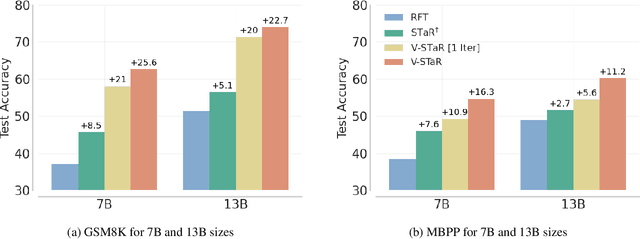
Abstract:Common self-improvement approaches for large language models (LLMs), such as STaR (Zelikman et al., 2022), iteratively fine-tune LLMs on self-generated solutions to improve their problem-solving ability. However, these approaches discard the large amounts of incorrect solutions generated during this process, potentially neglecting valuable information in such solutions. To address this shortcoming, we propose V-STaR that utilizes both the correct and incorrect solutions generated during the self-improvement process to train a verifier using DPO that judges correctness of model-generated solutions. This verifier is used at inference time to select one solution among many candidate solutions. Running V-STaR for multiple iterations results in progressively better reasoners and verifiers, delivering a 4% to 17% test accuracy improvement over existing self-improvement and verification approaches on common code generation and math reasoning benchmarks with LLaMA2 models.
Guiding Language Model Reasoning with Planning Tokens
Oct 09, 2023



Abstract:Large language models (LLMs) have recently attracted considerable interest for their ability to perform complex reasoning tasks, such as chain-of-thought reasoning. However, most of the existing approaches to enhance this ability rely heavily on data-driven methods, while neglecting the structural aspects of the model's reasoning capacity. We find that while LLMs can manage individual reasoning steps well, they struggle with maintaining consistency across an entire reasoning chain. To solve this, we introduce 'planning tokens' at the start of each reasoning step, serving as a guide for the model. These token embeddings are then fine-tuned along with the rest of the model parameters. Our approach requires a negligible increase in trainable parameters (just 0.001%) and can be applied through either full fine-tuning or a more parameter-efficient scheme. We demonstrate our method's effectiveness by applying it to three different LLMs, showing notable accuracy improvements across three math word problem datasets w.r.t. plain chain-of-thought fine-tuning baselines.
 Add to Chrome
Add to Chrome Add to Firefox
Add to Firefox Add to Edge
Add to Edge